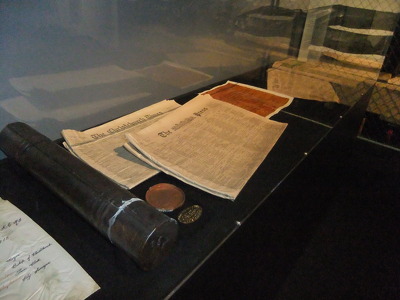
A photograph of a sign about liquefaction in the Canterbury Quakes exhibition at the Canterbury Museum.

A photograph of a sign in the Canterbury Quakes exhibition at the Canterbury Museum. The sign displays information about the 4 September 2010 earthquake.

A photograph of an exhibition sign next to the Speaker's Chair on display in the Canterbury Quakes exhibition at the Canterbury Museum. The Speaker's Chair stood at the southern end of the Stone Chamber of the Canterbury Provincial Chambers, and survived the 22 February 2011 earthquake despite the damage to the chamber.

A photograph of an exhibition sign next to the 'Quilt for Christchurch', in the Canterbury Quakes exhibition at the Canterbury Museum. The quilt was created by members of the public who sent squares to The Breeze radio station in Auckland.

A photograph of equipment from the New Zealand Fire Service Urban Search and Rescue team on display in the Canterbury Quakes exhibition at the Canterbury Museum. The equipment was used during the emergency response to the 22 February 2011 earthquake.

A photograph of a sign about liquefaction in the Canterbury Quakes exhibition at the Canterbury Museum.

A photograph of The Press newspapers on display in the Canterbury Quakes exhibition at the Canterbury Museum. The newspapers where discovered inside a time capsule found in the plinth of the statue of John Robert Godley in Cathedral Square after the 22 February 2011 earthquake.

A photograph of The Press newspapers on display in the Canterbury Quakes exhibition at the Canterbury Museum. The newspapers where discovered inside a time capsule found in the plinth of the statue of John Robert Godley in Cathedral Square after the 22 February 2011 earthquake.

A photograph of a quilt on display in the Canterbury Quakes exhibition at the Canterbury Museum. The quilt was created by members of the public who sent squares to The Breeze radio station in Auckland to be part of the 'Quilt for Christchurch'.

A photograph of a sign about liquefaction in the Canterbury Quakes exhibition at the Canterbury Museum.

A photograph of a sign in the Canterbury Quakes exhibition at the Canterbury Museum. The sign displays the number of aftershocks in Canterbury since the 4 September 2010 earthquake as of 9.00 am on the morning the photograph was taken. The tally was 9,787.

A photograph of a sign in the Canterbury Quakes exhibition at the Canterbury Museum. The sign displays the first Christchurch earthquake tweet on twitter, "Quake!!!!!!".

A photograph of an exhibition sign next to the ChristChurch Cathedral cross. The cross was on display in the Canterbury Quakes exhibition at the Canterbury Museum.

A close up of damaged stonework of Christ Church Cathedral.

The front of Christ Church Cathedral. The upper part of the front wall has crumbled leaving the inside space exposed. Steel bracing has been placed against the front wall to limit further damage.

A close up of a broken stained-glass window of Christ Church Cathedral.

A crane stands next to the Millennium Hotel and the BNZ building.

A red double-decker tour bus sits outside the former Registry building of the Christchurch Arts Centre. A broken window has been boarded up and security fencing has been placed around the building. A sign pointing towards the Christchurch Art Gallery is attached to the fence.

Two pigeons sit on top of the damaged stonework of Christ Church Cathedral.

Damaged brickwork of Christ Church Cathedral. The outer layer of stonework has fallen away revealing red bricks on the inside.

A close up of the damaged stonework of Christ Church Cathedral. The upper part of the front wall has crumbled leaving the inside space exposed. Steel bracing has been placed against the wall to limit further damage.

A close up of the damaged tiles and stonework on the roof of Christ Church Cathedral.

The Christchurch Art Gallery Te Puna O Waiwhetu on Montreal Street.

A pile of demolition rubble on Gloucester Street. The site was formerly that of the Brannigans building.

A close up of cracks running through the stonework of Christ Church Cathedral. Bracing has been placed against the front wall to limit further damage.

A panoramic photograph taken at the front of Christ Church Cathedral. The front of the cathedral has steel bracing against it to limit further damage. The upper part of the front wall has crumbled completely, exposing the inside space. The Chalice sculpture is to the right and the BNZ building can be seen in the background.

The north side of the cathedral with its boarded-up windows. Shipping containers have been placed next to the cathedral to protect the street from falling rubble. The Citizens' Memorial stands to the right.

Members of the public take photographs of the damage to the north side of the cathedral. Steel bracing supports the front wall of the cathedral.

A card at Christ Church Cathedral reads, "Sad goodbye to the grand old lady of Christchurch. Wonderful memories, never forgotten."

A close up of a broken window of the former Government Life building in Cathedral Square.